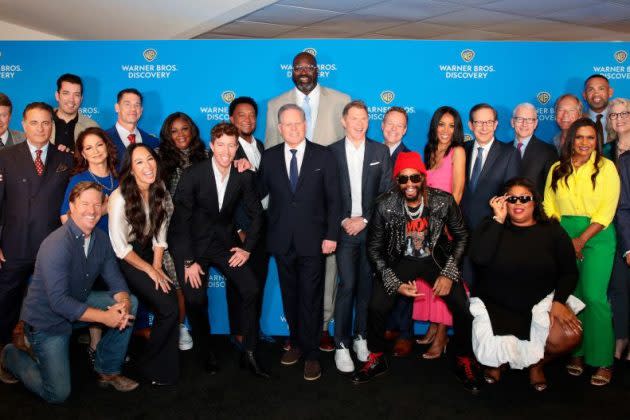With HBO Max and Discovery+ Expected to Merge, Streamers Debate Scale vs. Brand Identity
- Oops!Something went wrong.Please try again later.

Warner Bros. Discovery is about to find out whether bigger and broader really is better when it comes to streaming. Ever since he took over the merged company in April, CEO David Zaslav has been clear about his vision for one global platform, and with the company’s latest earnings release this week, Wall Street anticipation about details regarding about a paired-up HBO Max and Discovery+ is growing.
This would enable people who signed up to binge-watch “Barry,” “Succession” and “Last Week Tonight With John Oliver” to get their fill of “Naked and Afraid” and hundreds of hours of the excitable Food Network personality Guy Fieri hosting supermarket competitions and chowing down on chicken-fried steak or meatloaf at dining hot spots.
More from Variety
'She-Hulk' Pushes Back Premiere Date at Disney+ as 'Dancing With the Stars' Season 31 Sets Debut
HBO Max Quietly Removed Six Warner Bros. Streaming-Exclusive Movies
Why Warner Bros. Killed 'Batgirl': Inside the Decision Not to Release the DC Movie
Will the two fit together? The names HBO and Discovery “do mean different things to different people,” says Allen Adamson, managing partner of Metaforce, a branding consultancy. And that might create a challenge, he adds, when it comes time to sell potential subscribers on a combined service: “The broader the brand, the more things you try to stand for.” Warner Bros. Discovery declined to make executives available for comment.
The mega studio isn’t the only one grappling with the best way to present offerings in the hypercompetitive streaming space.
Disney+, for example, has earned a reputation for offering family-friendly fare and programs parents and kids can watch together. The service has even gone so far as to tell advertisers that it will not accept ads for alcohol or political campaigns when it launches a commercial-supported tier later this year. But that hasn’t stopped Disney from adding adult-skewing superhero fare like “Deadpool” or “Jessica Jones” to its library. In the documentary world, observers raised their eyebrows when Disney bought “Mija,” an immigrant tale that addresses the lives of undocumented families, after its Sundance debut; it will debut this month on the Mouse House’s streaming service, where it will be offered along with shows such as “Doogie Kamealoha, M.D.” and “Ms. Marvel.”
Netflix has also thrived — until recently– by offering something for everyone. The service has series for kids and pre-teens, to be sure, but is also readying the launch of the Marilyn Monroe biopic “Blonde,” which is expected to carry an NC-17 rating. Winnowing down choice doesn’t seem to be an option. One lapsed subscriber (this reporter) recently received an email pitch from the company touting its “thousands of new TV shows and movies.”
Veteran marketing executives have long espoused the idea of defining a brand’s core audience and going after it with all the data science and media targeting one can muster. And indeed, some streamers have identified a core constituent. Fox Nation has worked to provide a suite of content for conservatives. The now-defunct CNN+ initially sought out “super fans” of the longstanding news outlet who were interested in topics like business, food and travel.
But many of the services aren’t following that strategy. Research by Known, a marketing agency that has worked on several big launches for streamers, shows that consumers are gravitating toward buying “one of the longstanding offerings in the space, and then probably one and maybe two, but definitely not three more things,” says Kern Schireson, Known’s CEO.
He likens the challenge ahead for streaming outlets to old efforts by food or cereal companies to sell a “variety pack” of flavors. “You know you need vanilla. You probably need peach. What are the two other flavors I need” that will get people to make a purchase, asks Schireson.
Netflix, Warner Bros. Discovery, Disney and the rest can pull different levers than advertisers did in the past. The more customers the streamers attract, the more copious amounts of information they generate about what people really like – which helps them figure out what to produce to keep additional customers signing up to watch.
“If you and I both subscribe to Netflix, we probably subscribe for very different reasons. The content you enjoy on Netflix is probably different from the content I enjoy,” says Michael Smith, a professor of information technology and marketing at Carnegie Mellon University. “The brand is important for attracting consumers, but what I think is important for retaining customers is the ability to use data to direct customers to exactly the right piece of content.”
That doesn’t mean the streamers have permission to pack all kinds of disparate formats under a single umbrella. It remains to be seen, for example, whether Warner Bros. Discovery will ask subscribers of Discovery+ or HBO Max to pay more for the privilege of gaining access to a combined content offering some may not want. And despite the availability of robust parental controls, Disney+ for many parents is supposed to be a venue that doesn’t require them.
While consumers have certain expectations of names like Disney and HBO, says Adamson, the consultant, what they truly want is a good new show to watch. “They are looking for a ‘Marvelous Mrs. Maisel,’ not an Amazon Prime show,” he says.
Bigger might be better for streamers – at least for now. Even as they try to grow, the broadband outlets can’t lose their fine touch. They still need to crank up their algorithms to keep subscribers hopping to something new rather than churning over to a rival. In other words, the people behind Netflix, HBO Max and Hulu really need to sweat the small stuff, too.
VIP+ Analysis: Inside the Brave New World of Streaming Ads
Best of Variety
Sign up for Variety’s Newsletter. For the latest news, follow us on Facebook, Twitter, and Instagram.
